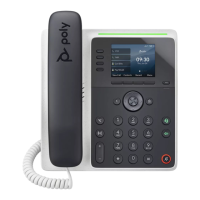1 Go to Messages.
2 Select Instant Messages.
3 If you have multiple lines on your phone, select a line.
4 From the Instant Messages screen, select the New softkey.
5 Enter a contact's phone number, URL, or IP address, then select OK.
The phone number, URL, or IP address you enter displays on the screen.
6 Do one of the following:
• Press Select to choose a prescripted message from the Message Select screen.
• Select Edit to compose a custom message, then enter your message.
7 Select Send.
Read Instant Messages
Instant messages display in the order that your phone receives them.
Task
1 Go to Messages.
2 Select Instant Messages.
3 Optional: If you have multiple lines on your phone, select a line.
The first message that you receive displays.
4 Select the Next or Previous softkey to read additional messages, if available.
Reply to Instant Messages
After you read an instant message on your phone, send a reply to the message.
Task
1 Go to Messages.
2 Select Instant Messages.
3 From the Instant Messages screen, select a message and select Reply.
4 Enter a message and select Send.
Delete Instant Messages
Delete old instant messages from your phone to reduce memory consumption.
Task
1 Go to Messages.
2 Select Instant Messages.
3 Select a message and select Delete.
Broadcasting Messages with Group Paging
Group paging lets you send pages—one-way audio announcements—to contacts subscribed to a page group.
Your administrator can enable a broadcast mode called group paging mode. In this mode, you can broadcast one-way
a
nnouncements to a specified group of phones, called a paging group
.
Your system administrator can define up to 25 paging groups and assign a label to each group to identify the phones in the
g
roup, such as All, HR Dept, Shipping Staff, or Executives.
Each group has one of the following priorities:
• Normal: By default, broadcasts sent to groups 1 to 23 are considered normal broadcasts. By default, all phones are
c
onfigured to receive broadcasts sent to group 1.
• Priority: By default, broadcasts sent to group 24 are considered priority broadcasts. A priority broadcast interrupts
Normal broadcasts or active calls. All phones receive priority broadcasts unless you enable Do Not Disturb.
71

